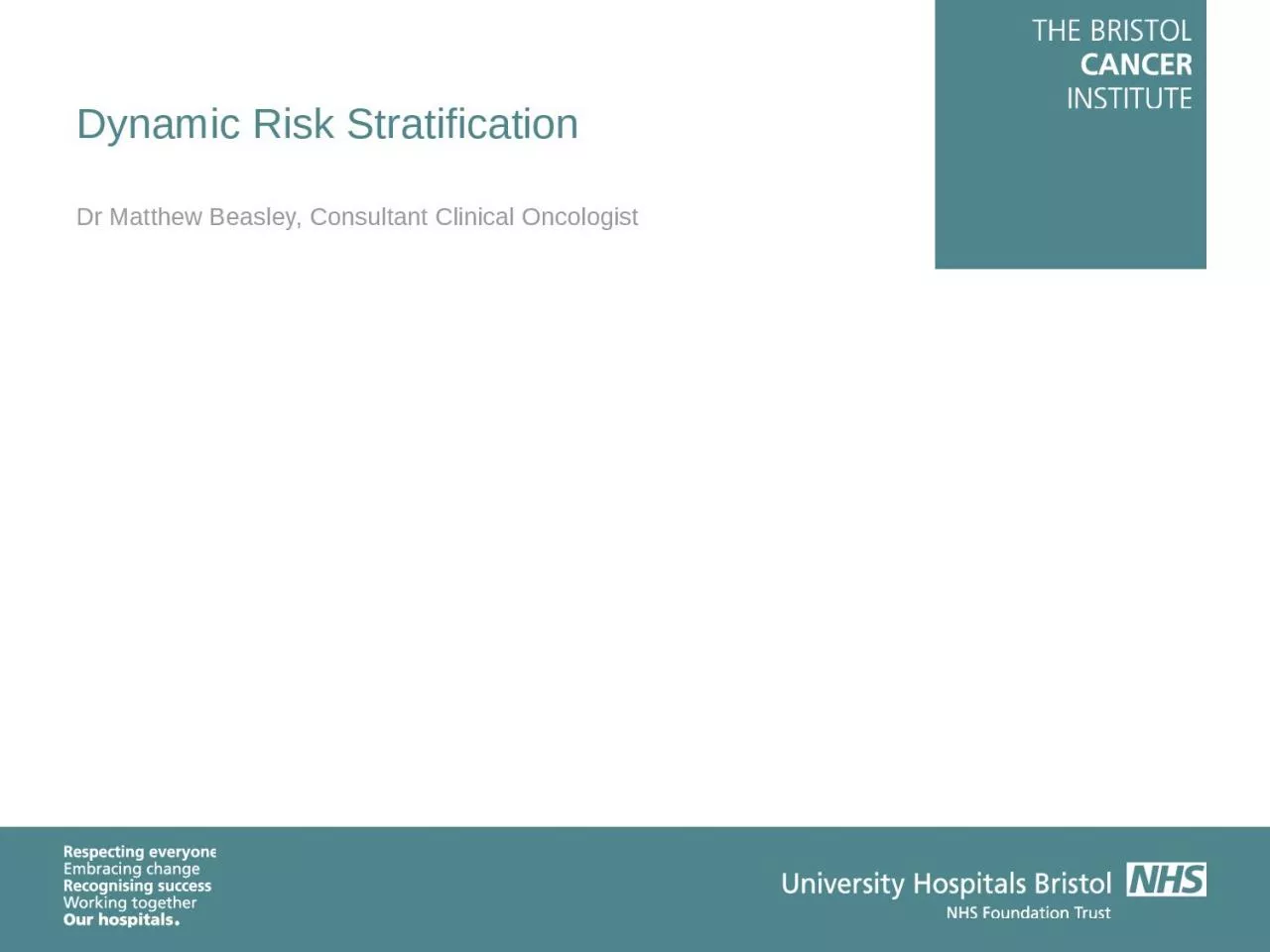

Dr Matthew B easley Consultant Clinical Oncologist Setting the scene An era of individualised risk stratified approach to management of differentiated thyroid cancer Current BTA Dynamic R ID: 930416
Download Presentation The PPT/PDF document "Dynamic Risk Stratification" is the property of its rightful owner. Permission is granted to download and print the materials on this web site for personal, non-commercial use only, and to display it on your personal computer provided you do not modify the materials and that you retain all copyright notices contained in the materials. By downloading content from our website, you accept the terms of this agreement.
Slide1
Dynamic Risk Stratification
Dr Matthew
B
easley, Consultant Clinical Oncologist
Slide2Setting the scene…
An era of individualised, risk stratified approach to management of differentiated thyroid cancer
Current BTA Dynamic
R
isk
S
tratification post treatment mandates stimulated
Tg
and neck ultrasound at 9-12 months
Applies to those who have had surgery and radio-iodine ablation
Determines the TSH target for follow-up
Slide3Dynamic Risk Stratification
Excellent Response
Indeterminate Response
Incomplete Response
All of the following
Suppressed and stimulated Tg < 1ug/l*Neck US without evidence of diseaseCross sectional imaging and/or nuclear medicine imaging negative (if performed)Any of the followingSuppressed Tg < 1ug/l and stimulated Tg ≥ 1 and < 10ug/l*Neck US with non specific changes or stable sub centimetre nodesCross sectional imaging and/or nuclear medicine imaging with non-specific changes, although not completely normalAny of the followingSuppressed Tg ≥ 1ug/l or stimulated Tg ≥ 10ug/l*Rising TgPersistent or newly identified disease on cross-sectional and/or nuclear medicine imagingLow riskIntermediate riskHigh risk
British Thyroid
Association Guidelines
3
rd
Edition
Clinical Endocrinology Volume
81. Issue s1.
Pages 1-122 July
2014
Slide4ATA Dynamic Risk Stratification
ATA
Guidelines Haugen BR et al (2016) Thyroid 26 (1)
Suppressed
Tg
target <0.2 ng/LRising anti-Tg Abs implies multiple readings?
Slide5Neck ultrasound
Asking our radiology colleagues to make a response assessment on ultrasound
O
perator dependent
Slide6Thyroglobulin (thyroid cancer blood tumour marker)
Colloid
Thyroid Follicle
TG
+ iodine + tyrosine
90% T410% T3
Slide7Thyroglobulin measurement
3 main methods
Radio-
immuno
assays first used in the 1980s
Novel highly sensitive 2 antibody “sandwich” immunometric assays introduced widely over the last decadeLiquid chromatography-tandem mass spectroscopyYYTGCapture AbSignal AbImmunometric assay
Slide8Thyroglobulin assays
Assay
RIA
Immunometric
LCMS
Functional sensitivity (ug/L)1.00.11.0Antibody interferenceResistantProblematicAbsentBetween method concordanceProblematicProblematicProblematicCost++++++Clinical evidence of utility++++?Radio-activity+--
Slide9TSH target
Excellent
response
Indeterminate response
Incomplete responseLow normal range (within normal range but</=2.0)0.1-0.5<0.1
Slide10Excellent response
achieved in 86%–91%
of ATA
low-risk patients
risk
of recurrence over 5–10 years of follow-up ranged from 1% to 4% (median 1.8%) in patients who had an excellent response to therapy by 6–18 months after total thyroidectomy and RAI remnant ablation (20 retrospective studies)intermediate-risk patients who achieve an excellent response, risk of recurrent/persistent disease decreased from 36%–43%(predicted by initial ATA risk stratification) to 1%–2% (predicted by response-to-therapy reclassification)The few high-risk patients that achieve an excellent response to therapy also have subsequent recurrence rates in the 1%–2% rangeATA Guidelines Haugen BR et al (2016) Thyroid 26 (1)
Slide11Indeterminate response
12%–29%of low-risk,
8%–23%of
int
-
risk and 0%–4% of high-risk15%–20% will have structural disease identified during follow-upATA Guidelines Haugen BR et al (2016) Thyroid 26 (1)
Slide12Incomplete response
Biochemical incomplete response
Biochemical incomplete response in 15-20% of patients
At
least 30%
spontaneously resolve to no evidence of disease20% achieve no evidence of disease after additional therapyUp to 20% develop structural disease (<1% disease specific death)Structural incomplete response2%–6% low risk, 19%–28% int risk, 67%–75% high risk50%–85% continue to have persistent disease despite additional therapyDisease specific death rates as high as 11%ATA Guidelines Haugen BR et al (2016) Thyroid 26 (1)
Slide13Non-stimulated sensitive
Tg
assays to define an excellent response
Author/Year
Patient
No.Time of assessment post ablationTg cut-off (ng/mL)Recurrence rateMalandrino (2011)4258-18 months<0.150% low risk, 1% int risk and 2.7% high riskBrassard M (2011)5893 months<0.271.5%Smallridge (2012)1631.8 years<0.14.3% low/int riskGionvanella(2009)1856 months<0.2 (and normal US)1.6% low riskGood negative predictive value
Slide14Position statement from international consensus panel 2012/2013
…an undetectable
Tg
value using a highly sensitive assay is associated with an adequate sensitivity and negative predictive value to obviate the need for measuring TSH-stimulated
Tg
concentrations.…but detectable basal highly sensitive Tg level (i.e. between 0.1 and 1ug/L) can only be considered disease free after a negative TSH-stimulated measurement.As most patients… low-risk DTC data on patients with intermediate and high risk tumours are less robustGiovanella et al (2014) Eur J of Endocrinol 171:33-46
Slide15Current algorithm
Neck US and
usTg
at 9-12 months
Neck US equivocal or anti-
Tg AbsNeck US shows residual diseaseExcellent responseIndeterminate responseIncomplete responseusTg≥ 1.0ug/LusTg < 0.1 ug/LNeck US no evidence of diseaseusTg ≥0.1 but <1.0 ug/LsTgsTg <1.0ug/LsTg≥1.0ug/L
Slide16Current algorithm
Neck US and
usTg
at 9-12 months
Neck US equivocal or anti-
Tg AbsNeck US shows residual diseaseExcellent responseIndeterminate responseIncomplete responseusTg≥ 1.0ug/LusTg < 0.1 ug/LNeck US no evidence of diseaseusTg ≥0.1 but <1.0 ug/LsTgsTg <1.0ug/LsTg≥1.0ug/L
?